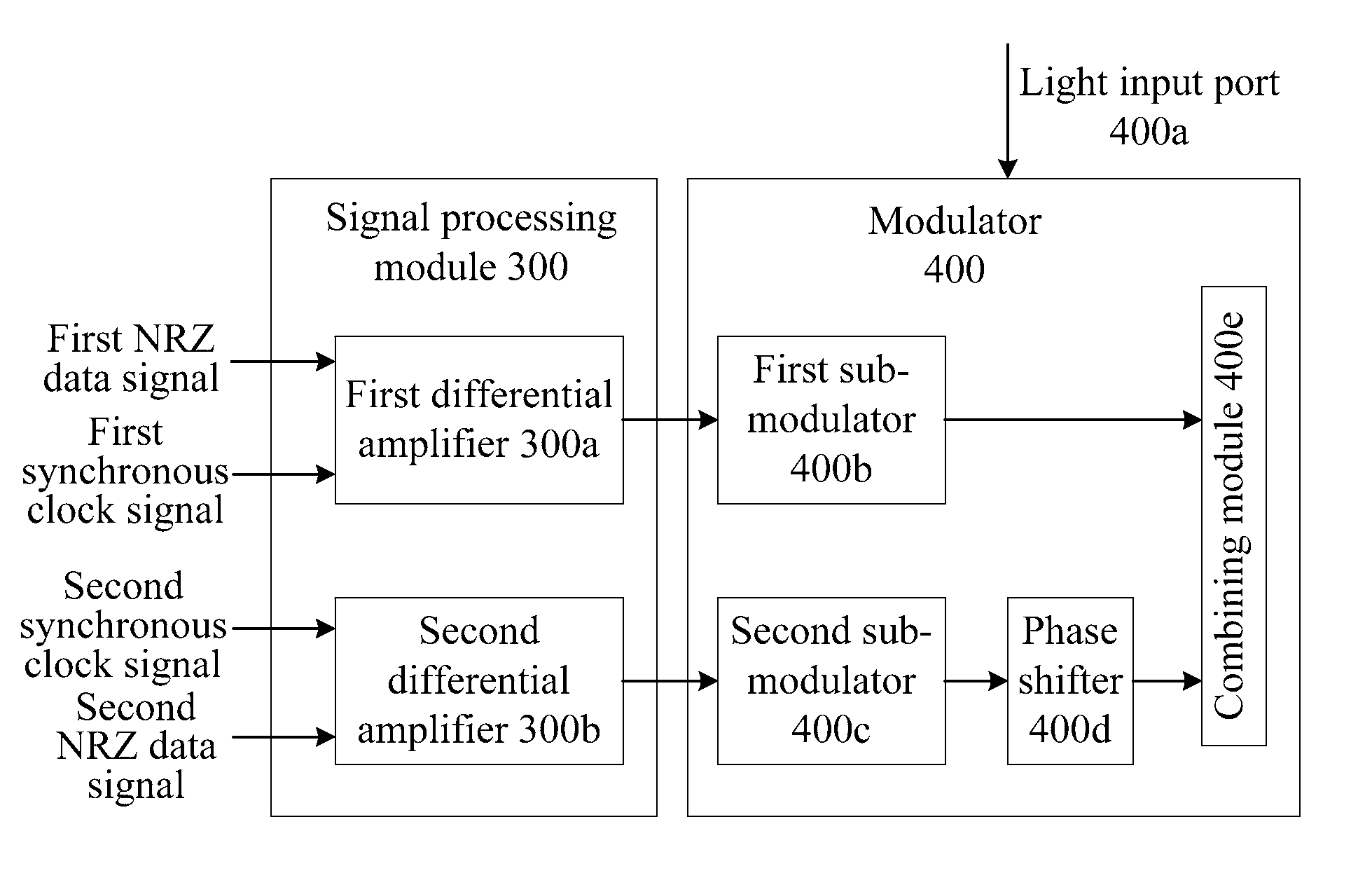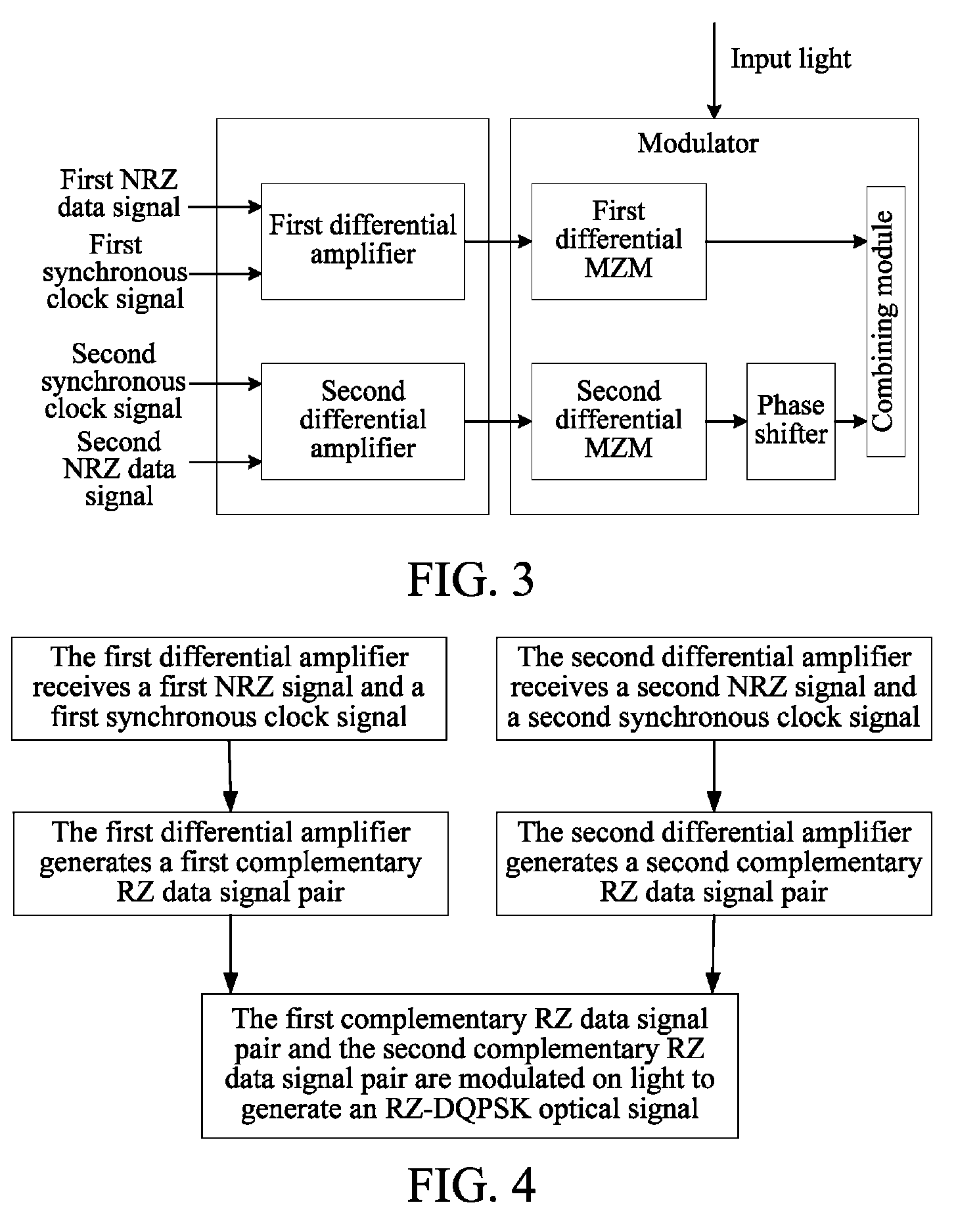Method and device for generating optical signals
a technology of optical signals and optical signals, applied in the field of communication, can solve the problems of large volume high cost, complex structure, etc., and achieve the effects of reducing the requirements for input optical, reducing the cost of the device for generating optical signals, and reducing the loss of insertion caused by the clock modulator
- Summary
- Abstract
- Description
- Claims
- Application Information
AI Technical Summary
Benefits of technology
Problems solved by technology
Method used
Image
Examples
embodiment 1
[0027]In this embodiment, two differential amplifiers respectively receive an NRZ data signal and a synchronous clock signal, and perform RZ processing on the two NRZ data signals to generate two RZ data signal pairs, where each pair of RZ data signals contain two complementary RZ data signals. At the same time, the two RZ data signal pairs are loaded onto a modulator to modulate light input into the modulator, so as to generate an RZ-DQPSK optical signal.
[0028]It should be noted that, although in this embodiment, two differential amplifiers are used to respectively receive an NRZ data signal and a synchronous clock signal and perform RZ processing on the two NRZ data signals, other manners may also be adopted, for example, two logic circuit units (for example, a combination of an AND gate and an OR gate) are used to respectively perform RZ processing on the two NRZ data signals, or an integrated differential amplifier or a logic circuit is used to load a synchronous clock signal fo...
embodiment 2
[0046]FIG. 7 shows a device for generating optical signals according to a second embodiment of the present invention. As shown in FIG. 7, the device includes a signal processing module 300 and a modulator 400.
[0047]The signal processing module 300 is configured to receive a first NRZ data signal and a synchronous clock signal, perform RZ processing to generate a first complementary RZ data signal pair, and output the first complementary RZ data signal pair; and receive a second NRZ data signal and a synchronous clock signal, perform RZ processing to generate a second complementary RZ data signal pair, and output the second complementary RZ data signal pair.
[0048]The modulator 400 is configured to receive input light, the first complementary RZ data signal pair, and the second complementary RZ data signal pair, and modulate the first complementary RZ data signal pair and the second complementary RZ data signal pair on the light to generate an RZ-DQPSK optical signal.
[0049]The signal ...
embodiment 3
[0065]In this embodiment, a device for generating optical signals is provided. The difference between this embodiment and the previous embodiment lies in that the signal processing module is an integrated differential amplifier, and the integrated differential amplifier receives a first NRZ data signal, a second NRZ data signal, and a synchronous clock signal simultaneously, where the three signals are synchronous (that is, the three signals have the same frequency and the same initial phase). It should be noted that, the synchronization of the three signals may be implemented by performing CDR through an existing PLL circuit. The three signals pass through the integrated differential amplifier, and according to the differential principle in the integrated differential amplifier, a first complementary RZ data signal pair and a second complementary RZ data signal pair are generated simultaneously, that is, one integrated differential amplifier achieves the functions of two differenti...
PUM
 Login to View More
Login to View More Abstract
Description
Claims
Application Information
 Login to View More
Login to View More - R&D
- Intellectual Property
- Life Sciences
- Materials
- Tech Scout
- Unparalleled Data Quality
- Higher Quality Content
- 60% Fewer Hallucinations
Browse by: Latest US Patents, China's latest patents, Technical Efficacy Thesaurus, Application Domain, Technology Topic, Popular Technical Reports.
© 2025 PatSnap. All rights reserved.Legal|Privacy policy|Modern Slavery Act Transparency Statement|Sitemap|About US| Contact US: help@patsnap.com



